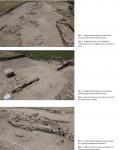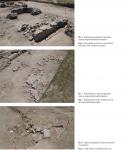Summary (English)
Colonia Flavia Scupinorum, or Scupi, is the biggest Roman city in Macedonia, the ruins of which are located in the NW part of modern-day Skopje. Thanks to the archaeological investigations since the period between the World Wars, remains have been documented since the Late Bronze Age until today, with intensive urban occupation during the Roman period and during Late Antiquity. A large number of buildings have been discovered, among which is a theater, several basilicas, baths, residential structures etc. In the focus of the 2018 investigations was the area delimited by the cardo maximus on the West and by the decumanus maximus one the South, where a basilica with a baptistery and an urban villa have been discovered previously. In this previously unexcavated part of the city, a new phase from the life of the settlement have been identified, and that is a Late Antiquity residential complex.
A more detailed documentation of the complex was not possible due to the bad preservation of the layer, but four aligned structures were identified which communicated with the open space to the north and south. They were built using stones, bricks, and clay, often with the reuse of material from the older buildings. The overall appearance of the remains suggests a level of degradation of urban life and a society with decreased financial power. In few locations outside of the buildings, hearts and cobbled areas were discovered, probably associated with economic activities. According to the artefacts discovered and the relative stratigraphic position towards the basilica and the urban villa, this residential complex existed at the end of the 4th and the beginning of the 5th centuries. After the residences were abandoned, the area was used for burials. Two graves were found – one elaborated grave structure with bricks, where a newborn was buried, and a simple pit where three individuals were randomly interred.
These investigations have demonstrated another phase of the inhabitation continuity in the central part of Scupi, where a residential complex was built right after a large urban villa was abandoned and just before the Christian Basilica was built.
Director
- Lenche Jovanova - Museum of the City of Skopje






![Download [PDF]](/excavation/skins/fasti/images/results/download_sml.png)

